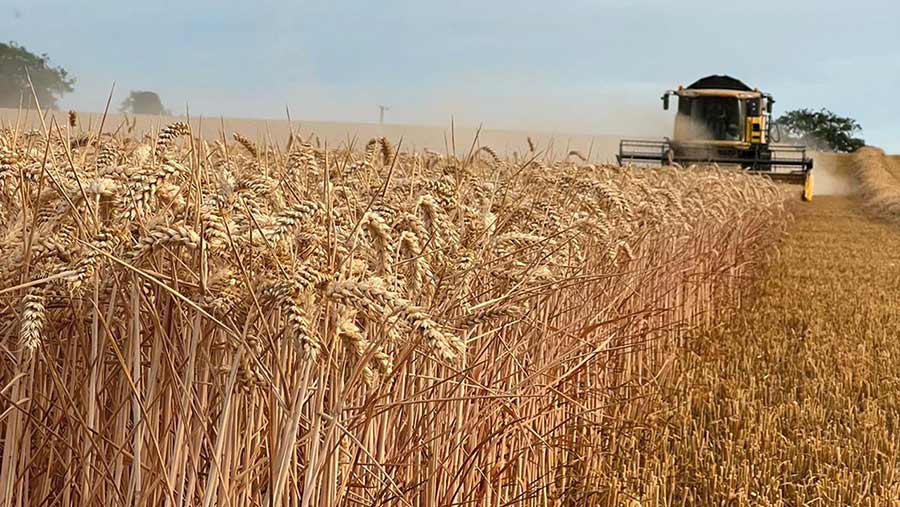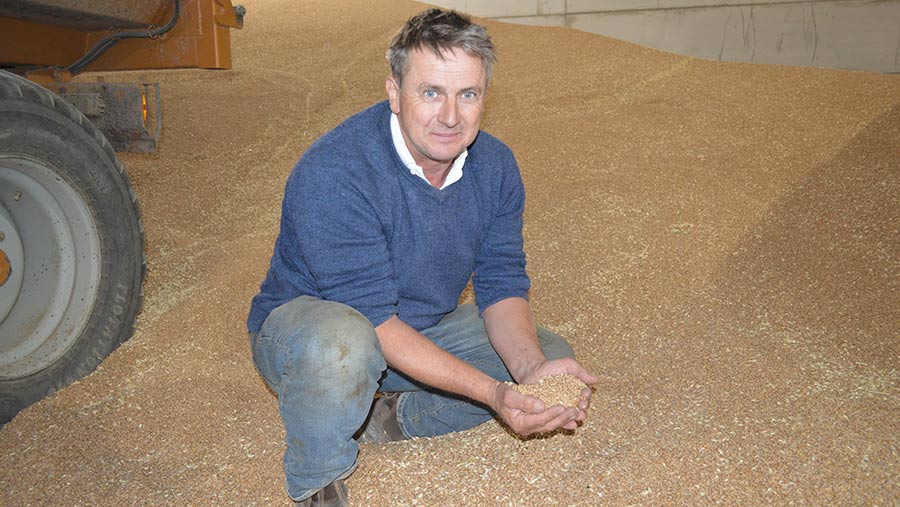New Group 2 milling wheat proves top yielder for Oxon farm
 The Passmore Brothers Palladium wheat © David Passmore
The Passmore Brothers Palladium wheat © David Passmore David Passmore saw a yield of well over 13t/ha for the new Group 2 milling wheat Palladium this summer on his Oxfordshire farm, and he believes the variety could have yielded even more with a bit more rain and was voted the best wheat crop in the county.
The specialist seed producer says the yield and quality were similar to fellow Group 2 wheat Extase, while the variety looked good throughout the year with a very stiff straw and was the top yielder on his farm. He will be growing it again in the coming season.
“It looks a good, solid, low-risk variety with good resistance to septoria and yellow rust, and had a stiffer straw than we suspected,” he tells Farmers Weekly.
See also: Kent growers assess two new Group 2 winter wheats

David Passmore © MAG/David Jones
Higher potential yield
He combined the Palladium during the first week of August, and says that with a little more rain in June and without the extreme hot weather in July, the variety could easily have yielded an extra 1t/ha.
This is his second year of growing the variety. The yield in his first year – like many wheats that year – was disappointing due to the lack of summer sun in 2021.
This year, the crop received only 96.9mm of rain between 1 April and harvest, some 25-50mm less than Mr Passmore calculated it needed to achieve its potential. But it still beat the farm’s five-year average wheat yield of 12-13t/ha.
He is particularly impressed by the stiff straw, and says its strength is as good as any variety the farm has grown. He says it is actually stiffer than the Recommended List would suggest at a rating of 7, similar to Extase, Dawsum and Gleam.
“You would do well to make it lodge as we put a lot of pig muck, digestate and compost on our land,” he says.

Harvesting Palladium wheat © David Passmore
Seed producer
All his 100ha of winter wheat is grown for seed on his family’s 325ha May’s Farm, just east of Wallingford, midway between Oxford and Reading on the edge of the Chilterns Hills.
Palladium is grown alongside other wheat varieties such as Zyatt and Cranium.
The farm grows four to five years of arable crops – such as winter wheat, oilseed rape, combine peas, spring barley and winter oats – on loamy chalk soils, and then three-year grass leys.
The Palladium was the third arable crop after grass, following winter wheat and peas.
Although he grows only seed wheat crops, he says he would consider Palladium to grow commercially as it looks a low-input variety with good standing power and, as a Group 2 milling wheat, has the chance of price premium.
The crop was drilled on 3 October using a Kverneland TS tined drill at a seed rate of 350/sq m, and it tillered well with quite a prostrate habit – which some growers may find useful in helping smother weeds.
Its relative slow growth means it could be a good partner for the fast-developing Extase.
Healthy crop

Palladium wheat © MAG/David Jones
The crop looked a picture of health from the start, and missed out on an early T0 fungicide spray as it was clean and the spring weather was very dry.
It received a T1 spray of SDHI fluxapyroxad and azole mefentrifluconazcole (Revystar), a T2 of fenpicoxamid plus azole prothioconazole (Univoq) and multisite folpet (Phoenix), and a T3 head spray of SDHI bixafen plus prothioconazole (Aviator) and strobilurin azoxystrobin (Amistar).
The average fungicide spend is about £120-£130/ha, and with average yield responses of about 3t/ha from fungicides and given the current high wheat price, the cost is easily paid for by the extra yield, he says.
The two key diseases which he worries about are yellow rust and septoria, and resistance score for the first is the highest available at 9 and the one-year septoria score is 7.2, compared with Extase at 7.3.
In the AHDB 1-9 scale, a high figure shows the characteristic to a high degree.
In the very dry spring, he held back on plant growth regulators and only applied the relatively inexpensive chlormequat at T0 and T1.
The crop had 200kg/ha of solid nitrogen fertiliser in a three-way split, in line with normal farm practice of 200-220kg/ha.
Subsequently, the crop was judged the “best field of wheat in Oxfordshire” in a competition involving eight farming clubs and thousands of hectares of wheat across the county. At harvest it showed 720 ears/sq m.
What the seed trade says
Palladium can be grown for milling or feed, is especially good as a second wheat due to good eyespot resistance, and could have enough seed available to take 3-4% of the wheat market this autumn.
Even though it is a Group 2 wheat, Palladium has the potential to match the grain quality of some Group 1s, while some growers will treat this newcomer as an easy-to-manage variety and produce it purely for feed.
Jim Knight, seed business development manager at agronomy and grain group Frontier, says signs are encouraging for the variety with a protein of 13.1% and hagberg of 315 when grown for milling, especially if there are fewer Group 1 wheats grown for harvest 2023.
Declining disease-resistance rating among Group 1 varieties, combined with the additional cost and risk of growing them, especially with high nitrogen prices, may cause some growers to question the viability of this market.
“Some end-users for breadmaking wheat are very enthusiastic about the potential for Palladium, but this is only its first year on the AHDB Recommended List,” he says. “We will have to wait to see if it gains wide appeal with the millers, but the early signs are very good indeed.”
Like Extase, Palladium is a clean variety with good resistance scores for septoria, yellow rust and mildew, while its 6 score for eyespot resistance is significantly better than Extase, making Palladium a good candidate as a second cereal.
Palladium can drilled early where grassweed control is not critical, and some growers may use Palladium for the early sowing slot and choose Extase for the main or later drilling window from October onwards.
Varieties such as Extase and Palladium do come with a slight yield penalty versus the latest Group 4 hard wheats, but Mr Knight says some growers will be prepared to accept this as the trade-off for better disease resistance.
“Our view is that it could achieve a 3-4% market share, but its potential this season will be constrained by the availability of seed,” he says.
What the plant breeder says
New Group 2 milling wheat varieties could offer growers an opportunity to achieve high yields and premium prices as there are few new top-quality Group 1 millers in the pipeline and there are disease concerns over old trusted varieties.
Varieties such as Extase, and now Palladium, from plant breeder KWS have produced good protein levels in the field, and may appeal to millers as old Group 1 varieties which look to meet miller’s need of 13% protein, such as Skyfall and Zyatt, suffer from yellow rust and Crusoe from brown rust.
Kirsty Richards, cereal product manager at the breeder, says: “There are already good 13% contracts out there for Extase and we fully expect Palladium to follow suit, opening up several more opportunities in the future.” She points out that Palladium has the highest protein at 13.1% of all the Group 2 wheats.
Olivia Potter, the group’s technical specialist, say the variety comes from a very different parentage to Extase so its septoria resistance has a different genetic basis than other commercialised Group 2 varieties.
“That adds diversity to the group and will help ensure we can maintain good levels of septoria resistance moving forward,” she says
Palladium has a one-year septoria resistance score of 7.2, similar to Extase’s 7.3, with a 9 for yellow rust, 8 for mildew, and a modest 5 for brown rust. Its fungicide-treated yield at 100 is a touch below Extase at 101, and its untreated yield of 90 is again just behind Extase’s 93. Specific weight for Palladium is a respectable 76.9kg/hl.
Take-all trials
Four wheat varieties showed an average yield response of 1.4t/ha when grown as second wheat and treated with a take-all seed treatment, which could become more relevant if more second wheats are drilled this autumn.
All wheat varieties are susceptible to the soil-borne pathogen take-all, although some are more tolerant than others.
There are no take-all resistance scores on the AHDB Recommended List, but varieties with good yields as second wheats show they can cope with root and stem diseases.
A second wheat trial was undertaken by crop consultant Adas in Herefordshire, looking at the yield responses of four KWS varieties – Zyatt, Extase, Palladium and Dawsum – when treated with the take-all seed treatment Latitude (silthiofam) from agrochem group Certis
The consultant’s plant pathologist Chloe Morgan says that by late May it was clear there was take-all in the trial, with distinct white heads and light-coloured patches seen as the pathogen damaged developing roots.
The season was favourable for take-all as a mild autumn and winter promoted primary infection and a dry summer exacerbated its symptoms.
The variation in varietal tolerance means there are differences in response to the seed dressing, as it gave a 1.85t/ha yield boost in Extase and 0.9t/ha in Palladium, suggesting that the latter may be good in a second wheat position.
She adds that the seed dressing is effective in reducing primary infection of take-all in the autumn when planting second or consecutive wheats, and it could be wise to include it as part of a risk management strategy.
“It’s a yield robber in fields where it’s severe, and cultural control options post-sowing are limited. Rolling post-drilling and early nitrogen can help, but neither are likely to be as effective as a seed treatment,” she says.

